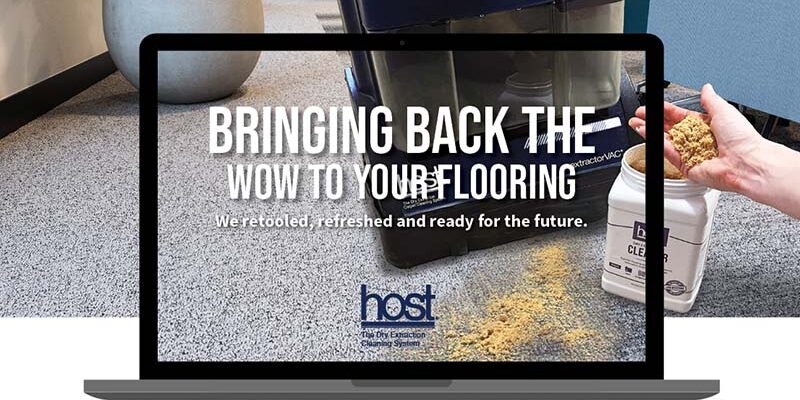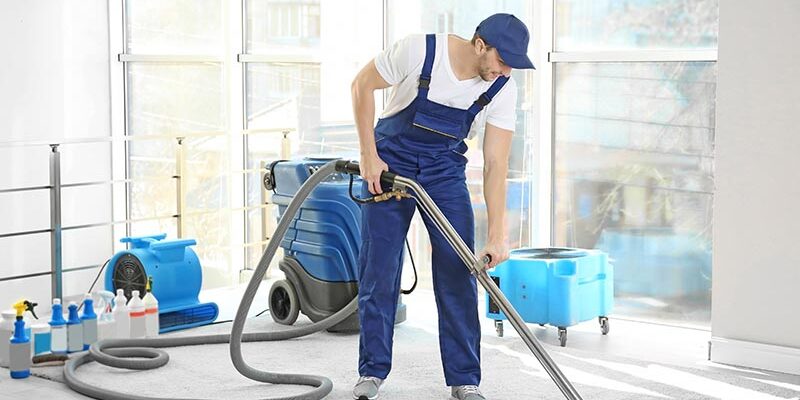Fiber Cleaning Challenges

By Jim Smith
From day to day and job to job, cleaning challenges change all the time. When cleaning fibers, professional cleaning technicians must know the type and specifications of the fibers they are working with—and which methods and products will yield the best fiber cleaning results.
Let’s look at the fibers that cleaning technicians will encounter on the job, what they need to know about them, and the unique challenges each fiber exhibits.
Polyester
The most significant issue cleaning technicians will face with polyester is maintaining its original appearance, which often suffers from texture issues. Polyester lacks resiliency and readily shows abrasions from usage and maintenance. These abrasions impede its ability to reflect light, making it look darker than intended even if it is clean.
Improper cleaning agents may also leave behind a sticky residue that leads to resoiling issues, further affecting polyester’s appearance, but this is more of a problem for triexta and olefin fibers. Some general cleaning guidelines include the following:
- Use a vacuum cleaner that has received a Seal of Approval (SOA) designation from the Carpet and Rug Institute.
- Apply strong alkalines or bleaches when needed, as they are unlikely to adversely affect the dye in the polyester as long as the products are made for the carpet cleaning industry.
- Prepare for a potentially tougher cleaning job; the resiliency of polyester is more challenging than that of nylon and wool fibers, but a high density and a shorter pile height can offset this.
- Although polyester is suited to all cleaning methods, be aware that absorbent pad extraction, or bonnet cleaning, will likely violate the manufacturer’s specifications and void the warranty; in addition, the bonnet may act like sandpaper if soil is not thoroughly removed before employing this method and may damage the fibers.
Triexta
The greatest challenge of triexta is its texture; these texture issues are likely to come from using an improper vacuum cleaner and employing cleaning methods not recommended by the manufacturer. To clean triexta, follow these guidelines:
- Use special SOA-approved vacuums with soft brushes.
- As with polyester, apply strong alkalines or bleaches if those products are made for the carpet cleaning industry.
- Although its resiliency depends on its density and pile height, expect it to perform better than many polyesters.
- Anticipate resoiling issues from sticky residues more so than with polyester.
- Use only water rinse extraction and absorbent compound extraction; for water rinse extraction, avoid detergents known for their high performance and sticky residues, use 300 psi or less for pump pressure, and use SOA-approved products to avoid issues with warranty claims; for dry compound extraction, use an oleophilic absorbent and its softest brush.
Nylon
Nylon’s challenge originates from improper chemistry. Aqueous substances such as food and beverages will stain nylon if it’s not protected with an acid dye blocker. Further, this acid dye blocker is incompatible with strong alkalines, cationic surfactants, and optical brighteners.
Cleaning technicians should apply products with caution; strong acids will likely dissolve or melt the fibers, and alkalines and bleach may remove the color. Nylon can also lose its color from strong reducing and oxidizing agents. Some general guidelines to follow are:
- Use SOA-approved vacuum cleaners.
- Expect excellent texture retention and appearance retention for a synthetic, but less than that of wool.
- Understand that apparent soil from scratches on the filaments will be less than that of polyester and olefin.
- Evaluate the pile height, pile density, and heat set before employing agitation on cut loop piles, and know that anything beyond that of a water rinse extraction wand or a soft brush in dry absorbent compound extraction should not be used if there is a propensity to lose the yarn definition; in addition, although nylon is suited to many cleaning methods, beware that absorbent pad extraction will likely violate the manufacturer’s specifications, voiding the warranty.
Olefin
Olefin’s greatest challenge is appearance retention because it lacks resiliency and is susceptible to abrasions. It may also have resoiling issues from sticky residues, and it may become stiff and darken if it is a fine-denier velvet. Cleaning guidelines include the following:
- Use SOA-approved vacuum cleaners.
- lean with care; of all these fibers, olefin is the most sensitive to heat, can be permanently damaged when heavy objects such as desks are moved across it, and can also be distorted by hot hoses from truckmounts.
- Expect resoiling issues from sticky residues more so than with triexta.
- Employ ultraviolet technologies with caution because this fiber is the most sensitive to ultraviolet light.
- Prepare for a challenge in terms of texture retention and appearance retention; olefin is the least resilient of all petroleum-based synthetics, and apparent soil from scratches on the filaments will be worse than with polyester.
- As with polyester and nylon, olefin is suited to all cleaning methods, but know that absorbent pad extraction may void the manufacturer’s warranty.
Wool
Challenges when cleaning wool come from its alkalinity, not from its pH. The pH of a product is but one aspect of its alkalinity and does not represent all there is to know about potential adverse effects.
The fiber’s pH should be measured directly from its face yarn with a flat-surface pH meter. Acid-dyed wool will have a pH between 2.5 and 5.5, but it has been known to bleed in buffered detergents, even with a pH of 6.5. Further, it will experience a degradation known as felting if it is cleaned with unbuffered alkalines. Some general guidelines to follow when cleaning wool are:
- Use WoolSafe-approved products.
- Follow the manufacturer’s cleaning specifications: If, for example, the fiber’s pH is between 6.1 and 6.7 and it has never been cleaned before, the colorants are probably the natural color of the animal, and the manufacturer’s instructions will likely allow for only dry compound extraction or dry foam extraction.
- Use cleaning methods that are approved by WoolSafe.
Rayon
Rayon goes by many names including viscose and art silk. With this fiber, cleaning technicians will be challenged by fiber loss due to abrasion or bending of the yarn, especially when it is wet. Rayon should be considered a decorative fiber with a practical life of one year or less. Some general guidelines to follow when cleaning include:
- Vacuum it without a beater bar (with suction only).
- Use the dry compound extraction cleaning method with the softest brush possible.
- If the fibers are wet, dry them quickly to avoid a total loss.
Knowing the issues associated with each type of fiber will help professional cleaning technicians achieve the best results. With the appropriate methods, tools, and products, cleaning technicians will be able to handle any challenge they encounter—leaving behind a cleaner space and satisfied clients.
[infobox title=’Triexta and Polyester’]
Mohawk Carpet makes the lion’s share of triexta and calls it SmartStrand®. But is triexta just a newer version of polyester? Both belong to the same family of fibers, but how different are they, and how important is this to know?
Floor Covering News reported that, for the 2019 residential carpet and rug fiber market, polyester made up 59% of the market, while triexta made up 18%. Compared with nylon at 16%, polyester and triexta combined encompassed 4.8 times more of the market.
The federal government’s opinion
The United States government believes that triexta is different from polyester, and the Federal Trade Commission recognized it on March 20, 2009. According to the government, triexta significantly outperformed polyester on the heaviest of wear-cycle tests. Others have said that it even outperforms nylon.
An absorption comparison
Polyester and triexta are oleophilic—that is, they like oil. When a material likes oil, it generally does not like water. The relationship between being hydrophilic (likes water) and oleophilic is like a seesaw; when one characteristic goes up, the other comes down and vice versa. Some have placed polyester’s absorbency of water between 0.4% and 0.8%, whereas triexta’s absorbency has been placed at 0.1%. This indicates that triexta is more oil loving than polyester is.
Mohawk Carpet’s guidelines
According to Mohawk, a limited number of vacuum cleaners are recommended for use on triexta. In addition to being SOA approved, those approved for triexta are known for their soft brushes.
For professional cleaning, Mohawk’s triexta cleaning guidelines recommend only water rinse extraction and dry compound extraction. For dry compound, I suggest using an oleophilic absorbent and the softest brush available. For water rinse extraction, Mohawk recommends keeping the pump pressure under 300 psi.
The protector issue
In the past, many fluorochemical protectants have not bonded to triexta, but advancements are being made to overcome this. The second generation of triexta was introduced in December 2014 with a protector called Nanoloc®, which Mohawk said was the first protector compatible with SmartStrand.
Advice for cleaning triexta
My recommendation is to note the contrast and to follow the manufacturer’s specifications. If using water rinse extraction, or hot water extraction, do not use a mechanical brush agitator or a motorized wand. Adjust the pump pressure down, use glides, and avoid high-performance rinse solutions that are based on sticky surfactants. These surfactants may form a strong bond that will end up attracting soil. Also, a brush instead of a comb may be a more effective grooming tool on cut loop.
Fiber identification
How do you tell the difference between polyester and triexta? The end user may know, but if not, what about testing? The chemical and burn tests for each fiber yield the same results.
Frequently, triexta will have a softer hand compared to polyester. Cleaning technicians can also evaluate the fiber type based on pile distortions; any fiber that shows significant pile distortions should be cleaned with less agitation.
The commercial market
For the commercial market, triexta has an approximate 2.5% market share. However, in 2009 it made up less than 1% of the residential market. It is likely to grow.
Some final questions
For years we have studied the generations of nylon and have considered it to be the focal point of cleaning, and we have discussed at length the rules of cleaning and care. Are the alkalinity rules and the compatibility issues associated with cationic surfactants relevant to polyester and triexta?
Further, are your accreditations and certifications keeping up with the changes in the industry? Are cleaning technicians being taught the manufacturer’s guidelines? Failing to comply with the manufacturer’s specifications may not go well for cleaners who find themselves in litigation on a warranty issue.
[/infobox]
James “Jim” B. Smith is an IICRC-approved instructor and a senior practicing inspector. His educational studies come from Texas A&M University and the University of Houston. He has been in the cleaning industry since 1975. For more information, visit his website at carpetinspector.com/jbs or email [email protected].












